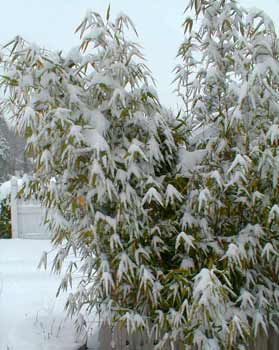
"Muchisasa" Bamboo
"A cuckoo cries,
& through a thicket of bamboo
the late moon shines."
-Matsuo Basho,
1644-1694
1644-1694
Shown after a January snowfall, for a long time I did not know what kind of bamboo this was. It was a gift from a friend who said it was sold to her as "black bamboo," but at first it certainly didn't seem likely to be Phyllostachys nigra which is much taller, with culms that on the most prized forms are droopier & age to a shiny gorgeous purplish black.
This one, however, grew to only eight or ten feet of height, vastly smaller than the average species of Phyllostachys. The culms sometimes become so heavy with densely leafed branches that they end up drooping a bit, but in the main it forms a very upright stand.
In color the culms are green to brown, with older culms & also the leaf-stems such a dark brown they approach being black, but never actually black.
It spreads rapidly, with three-fourths inch mature culms which are very hard & require a saw rather than pruning sheers to thin out. I cut culms out of it fairly regularly to thin it down, but new growth appear so rapidly with leaves so very thick, it forms an excessively dense stand.
It is fully evergreen & quite beautiful year-round, liking our temperate climate. The knife-like leaves are around six inches long, pointed, & quite narrow, growing very thick along the canes. It is sun-hardy never having been damaged by a sunny spot along the alley.
Though I know way too little about bamboos, it seemed obvious (or at least likely) that this is the genus Phyllostachys which includes rapid-spreading sun-lovers for temperate zones. This genus consists of plants that are overall genus vastly taller than ours, however, & judging by size alone, & by a tendency to darkness though not complete blackness of the canes, I soon discounted virtually all possibilities except P. nigra var. muchisasa, a comparatively small black-bamboo that indeed never gets truly black.
Of the many other species of Phyllostachys & the several other variants of P. nigra per se, I could not find a good discription of any that seemed even a secondary possibility. The additional fact that "Muchisasa" is not uncommon in cultivation seemed to cinch the identification. So until someone wiser about bamboos than I'll ever be says otherwise, this one goes down in my garden-book as "Muchisasa."
The barrier didn't work terribly well for this potentially harmfully invasive species. The wooden upper portion that forms the alley-side container is attached to a sunken metal barrier that goes down another two feet or deeper. But roots eventually went under the barrier & came up on the alley-side, where bamboo shoots pop up from time to time.
To completely contain such an aggressive bamboo would require a big buried rubbermaid livestock watering boat; I suspect this stuff could escape even through a small drainage hole.
As an organic gardener I would hate ever to find myself faced with a choice of letting an aggressive bamboo get out of hand, & fighting against its spread. Digging it up rarely works since any part of the rhizome that remains will generate more bamboo, & the use of dreadful herbicides does not merely contradict organic principles, but according to many gardener's reports works against all the plants in a yard except invasive bamboo! This is because glyphosate (the toxic killer in the most often used products like RoundUp) only barely effect bamboo, & in some cases would require regular applications for three years to have a chance of stopping the spread. Much stronger in its effect would be the herbicides hexazinone & imazapyr repeatedly applied to shoots as they emerge. The organic method of digging out what can be gotten, then keeping it flat to the ground until it exausts itself to death trying to grow back could take a decade of rigorous mowing.
Fortunately, with a parking tarmack on one side of this stand of bamboo, & the alley on the other, ours doesn't have a huge chance of spreading anywhere it doesn't belong. If too many shoots do begin to appear along the alley road, we could always harvest them as fast as possible for kitchen use. How much better it would have been, though, if I'd known it required a type of barrier with no route out through the bottom.